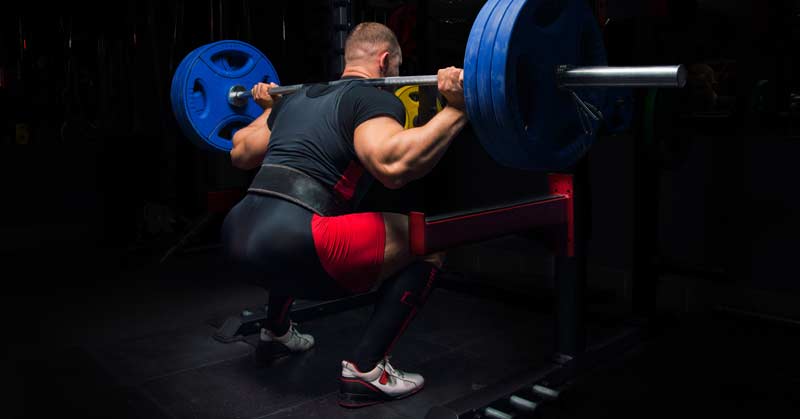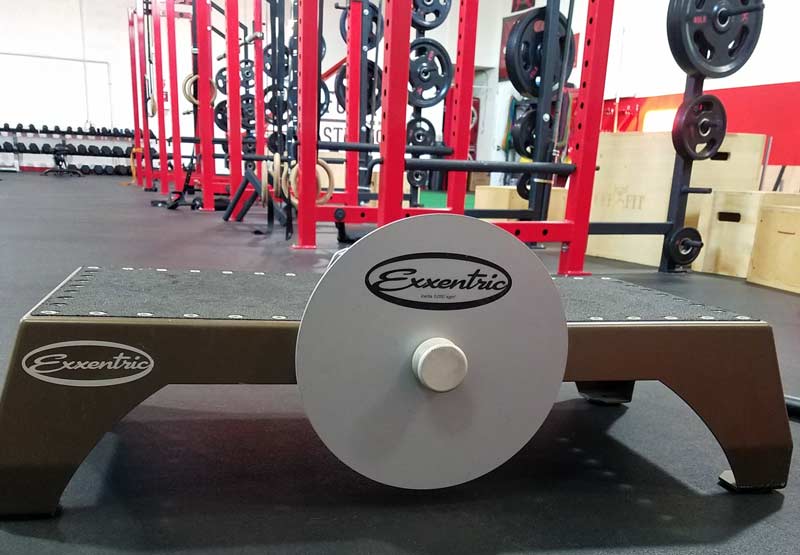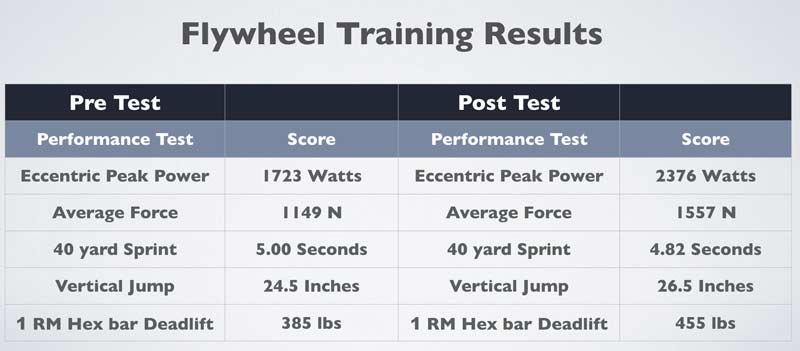
Ever since Cal Dietz wrote the book, Triphasic Training, there has been an increased focus on eccentric training for improved sports performance, and a lot of articles about progressions for eccentric training, reducing injury, and improving strength. One component that coaches may overlook is the speed at which athletes perform these eccentric contractions and the role that high-speed eccentric training can play in athlete development.
Much of the eccentric strength work in the past focused on time under tension and slow eccentrics to develop strength or hypertrophy. An example of this type of eccentric training for improving strength is an athlete performing a few sets of supramaximal squats with a four- to six-second eccentric contraction. This is great for improving strength, but at some point, the athlete needs to perform these eccentrics at much higher speeds and faster rates to mimic the forces placed on them when they sprint, cut, or land a jump during athletic competition. Strength coaches need to take these forces into consideration when developing a training program for their athletes.
Understanding the Role of Eccentric Muscle Actions in Sports
During an eccentric muscle action, “…the muscle lengthens because the contractile force is less than the resistive force.” (Haff, page 32) We see eccentric contractions all the time in sports. All field sports include large amounts of acceleration and deceleration within the game. Every time an athlete decelerates, their muscles produce an eccentric contraction.
During a game, an NFL player can hit speeds of 20 miles an hour within 20 yards. When these types of athletes change direction, they are not slowly performing eccentric contractions. These contractions occur with high force and high speed. You can determine one of the factors in an athlete’s speed or explosiveness by how quickly the athlete can absorb eccentric forces and generate a concentric muscle force. This is why prospects perform a three-cone drill every year at the NFL Combine. This test tells scouts the athlete’s change-of-direction ability, as well as their power.
When an athlete can quickly absorb an eccentric force and produce a concentric muscle contraction, they can take advantage of the stretch reflex of the muscle. If a muscle contraction is performed too slowly, the athlete will not be able to benefit from the stretch reflex. Performing variations of squats and deadlifts at slow speeds does not prepare athletes for all of the demands their muscles will experience in a game.
Training for Specificity of Eccentric Muscle Actions
Specificity of training should not only mimic the types of joint angles and movements the athlete will perform during competition, but also the speed of these movements. As coaches, why do we spend so much time trying to strictly develop strength, when we should spend more time doing overloaded eccentric training to better mimic the demands of the sport?
Wirth et al. (2015) conducted a study looking at the effects of eccentric strength training on maximal strength and speed-strength. Participants in the study trained eccentrically using supramaximal loads over a period of six weeks. After six weeks, the strength of the athletes improved greatly; however, vertical jump height showed no significant difference when compared to the control group.
The real benefit to #flywheel training is that the athlete creates the force, says @JFeairheller. Share on XLet’s look at the equation of power (Power = Force x Velocity) in reference to this study. The force of the athletes improved greatly, and just this alone should have increased their power compared to the control group. The only explanation for production of the same amount of power in the vertical jump as the control group is that the velocity at which they moved had to go down. If strength does not always translate to more power, we should look at alternative training methods to improve both strength and power.
Methods of High-Speed Eccentric Training
What are some of the best ways to increase these eccentric forces during training to emulate the speed of movements during competition? Louie Simmons popularized the use of bands when performing squats. To perform a squat with the band, you must attach the band at the floor or the bottom of the squat rack and then loop it around the bar. This setup will create more force to pull the athlete down into the squat than just with gravity alone. The bands definitely create a higher eccentric force, especially if you accelerate down with the weight, but I’ve found the kBox is the best option for high-speed eccentric resistance training.

The kBox uses flywheel technology and inertia to create resistance against the athlete. As an athlete accelerates up from the bottom of a squat, the flywheel speeds up. As the flywheel speeds up, it creates a larger eccentric force during the down phase of the squat. The real benefit to flywheel training is that the athlete creates the force, so you always work the optimal resistance for the athlete.
Inertial Training Improves Strength and Power
At Function and Strength, we completed a nine-week case study to look at the benefits of using high-speed eccentric training via the kBox. During the nine weeks, a highly trained male performed lower body exercises twice a week. The participant used only the kBox as the main component for his lower body days, along with some additional accessory lifts. Once a week the participant performed RDLs on the kBox, and once a week he performed squats on the kBox.
The subject performed all the reps at max effort with a focus on decelerating the flywheel as quickly as possible. We kept the sets and reps the same throughout the nine weeks, with the only change being the number of plates or amount of inertia the athlete used. For the first three weeks, he used two plates with an inertia of 0.050 kgm2. For weeks four through six, he used one plate with an inertia of 0.050 kgm2 and one with an inertia of 0.025 kgm2. Then for the last three week, he only used one plate with an inertia of 0.050 kgm2. Before and after the nine weeks, he performed the Go Exxentric 4RM Squat Power test on the kBox using one 0.050 kgm2 plate.
We used the kMeter to look at the eccentric peak power, as well as the average force produced. Table 1 shows the pre and post test results, looking at eccentric peak power, average force, 40-yard sprint, vertical jump, and a 1RM hex bar deadlift.

Not only did power and speed improve, but strength also showed significant improvement over the nine weeks. Based on these results, the ability to improve eccentric peak power and average force on the kBox yielded a faster 40-yard sprint by .18 seconds (3.6% improvement), a higher vertical jump by 2 inches (8.2% improvement), and a higher 1RM hex bar deadlift by 70 pounds (18.2% improvement). These results are consistent with some other studies performed by Gual et al. (2016), as well as Naczk et al. (2016). Both studies also looked at the effects of inertial training.
Gual et al. (2016) looked at the influence of a weekly bout of inertial squat resistance with eccentric overload on lower limb power. After going through a 24-week study, the results showed a significant improvement in countermovement jump compared to the control group, which did not perform the weekly bouts of inertial squat resistance with eccentric overload. Along with the improvement in jumping ability, both eccentric and concentric squat power showed significantly more improvement versus the control group.
Another study by Naczk et al. (2016) evaluated the strength and power of young active men after performing five weeks of inertial training. Before and after the study, the subjects were scored in countermovement jump, squat jump, maximum force, and maximum power achieved during an ergometer test. Following the five weeks of training, there were significant improvements in muscle force, muscle power, countermovement jump, and squat jump.
When comparing the case study, the Gual study (2016), and the Naczk study (2016) to the Wirth study (2015), there is one key difference. That difference is the speed at which the participants performed the eccentric portion of the exercise. All of the studies showed improvements in strength. However, when overloading the eccentric portion of the lift with higher speeds, we see a much better translation to power when compared to performing eccentrics slowly. This makes sense when looking at the dynamic movements of athletes because these types of exercises do a better job simulating the speed of movements during game play.
If you want to move fast, you have to train fast, says @JFeairheller. Share on XWhen a basketball player prepares to jump for a block or a rebound, they do not slowly lower themselves and then try to jump as high as they can. They lower themselves quickly and then jump up quickly. Training with high-speed eccentrics does a much better job of copying this movement speed. If you want to move fast, you have to train fast. Cal Dietz said “every dynamic movement begins with an eccentric muscle action.” (Dietz, page 83) The less time an athlete can spend in the eccentric portion of the movement, the more dynamic and powerful the countermovement becomes.
Shifting Toward a Better Training Model for Athletes
As strength coaches, we may have only a few months to train an athlete during the offseason. With this limited training time, it’s crucial to be as efficient with our programming as possible in order to see the best results with our athletes. Training with supramaximal eccentrics is great for someone looking to specifically improve strength. For athletes looking to improve power, change of direction, cutting, and jumping ability—along with strength—a good option is high-speed eccentric training.
Since you’re here…
…we have a small favor to ask. More people are reading SimpliFaster than ever, and each week we bring you compelling content from coaches, sport scientists, and physiotherapists who are devoted to building better athletes. Please take a moment to share the articles on social media, engage the authors with questions and comments below, and link to articles when appropriate if you have a blog or participate on forums of related topics. — SF
References
- Dietz, Cal, and Ben Peterson. Triphasic Training. 2012. Hudson, WI: Bye Dietz Sports Enterprise. Page 83.
- Haff, G. Gregory, and N. Travis Triplett. Essentials of Strength Training and Conditioning, 4th Edition. 2016. Champaign, IL: Human Kinetics. Page 32.
- Gual, Gabriel, Azahara Fort-Vanmeerhaeghe, Daniel Romero-Rodriguez, and Per A. Tesch. “Effects of In-Season Inertial Resistance Training With Eccentric Overload in a Sport Population at Risk for Patellar Tendinopathy.” Journal of Strength and Conditioning Research 30(7) (2016): 1834-1842. doi: 10.1519/JSC.0000000000001286Naczk, Mariusz, Alicja Naczk, Wioletta Brzenczek-Owczarzak, Jaroslaw Arlet, and Zdzislaw Adach. “Impact of Inertial Training on Strength and Power Performance in Young Active Men.” Journal of Strength and Conditioning Research 30(8) (2016): 2107-2113. doi: 10.1519/JSC.0b013e3182a993c2
- Wirth, Klaus, Michael Keiner, Elena Szilvas, Hagen Hartmann, and Andre Sander. “Effects of Eccentric Strength Training on Different Maximal Strength and Speed-Strength Parameters of the Lower Extremity.” Journal of Strength and Conditioning Research 29(7) (2015): 1837-1845. doi: 0.1519/JSC.0000000000000528.


Some flywheel devices are better than other to achieve peak eccentric and concentric power.